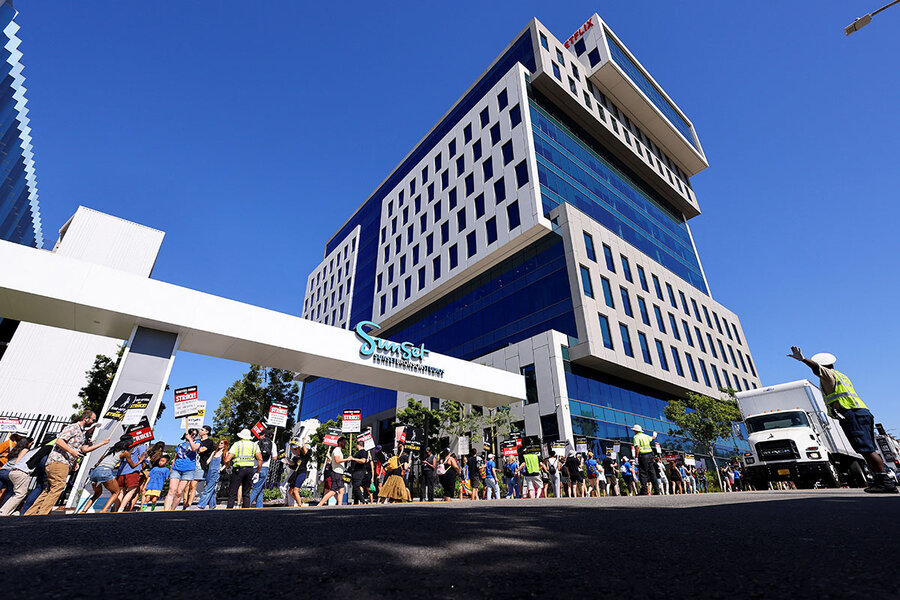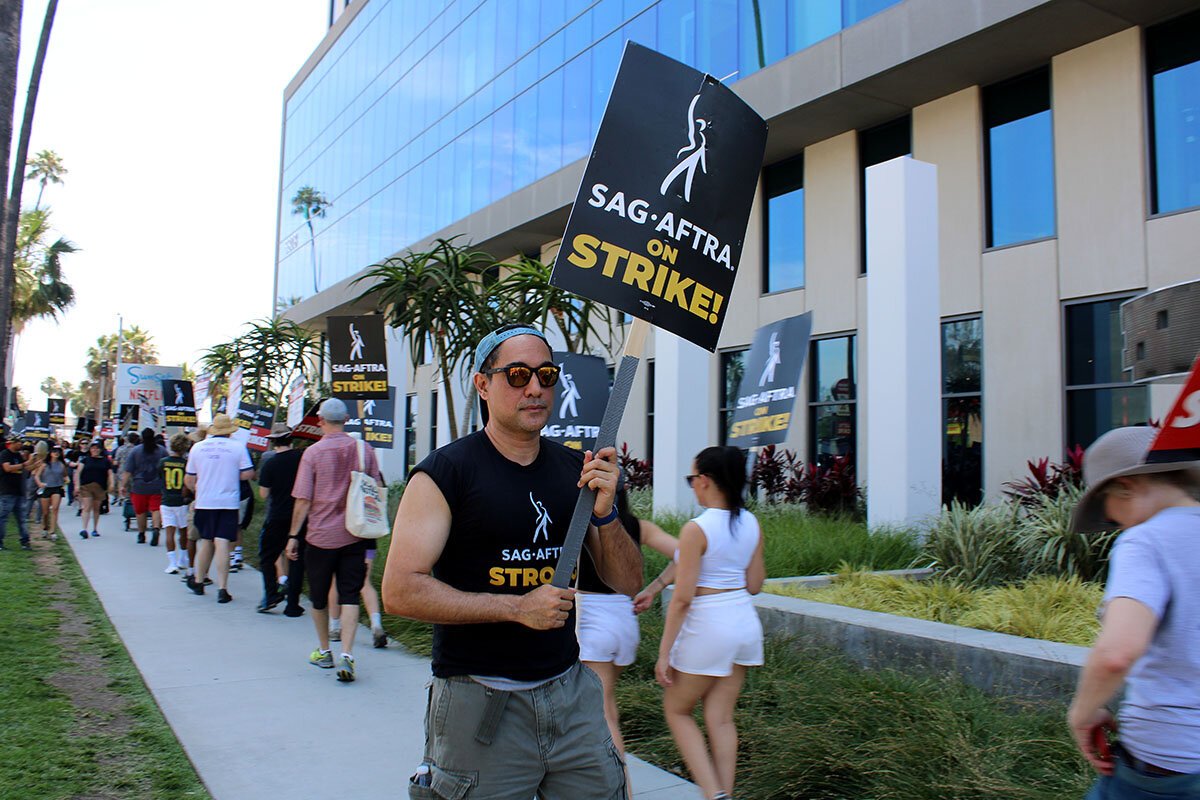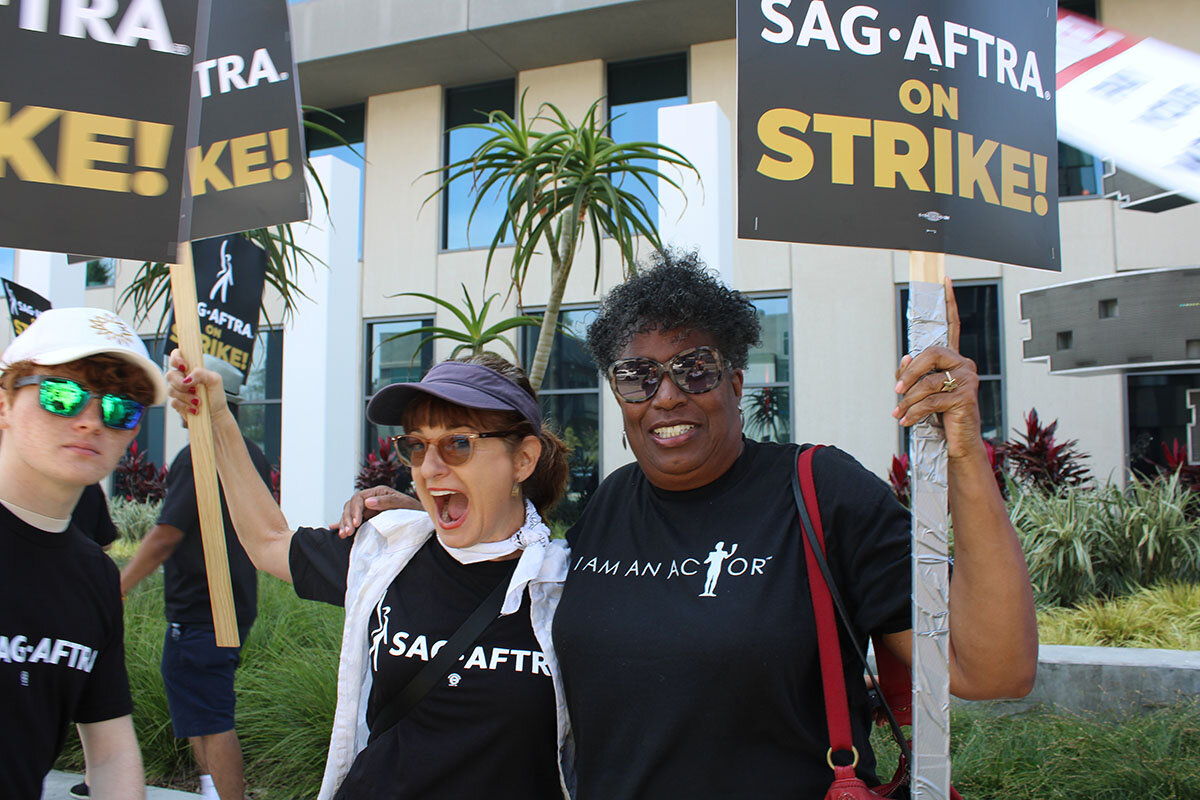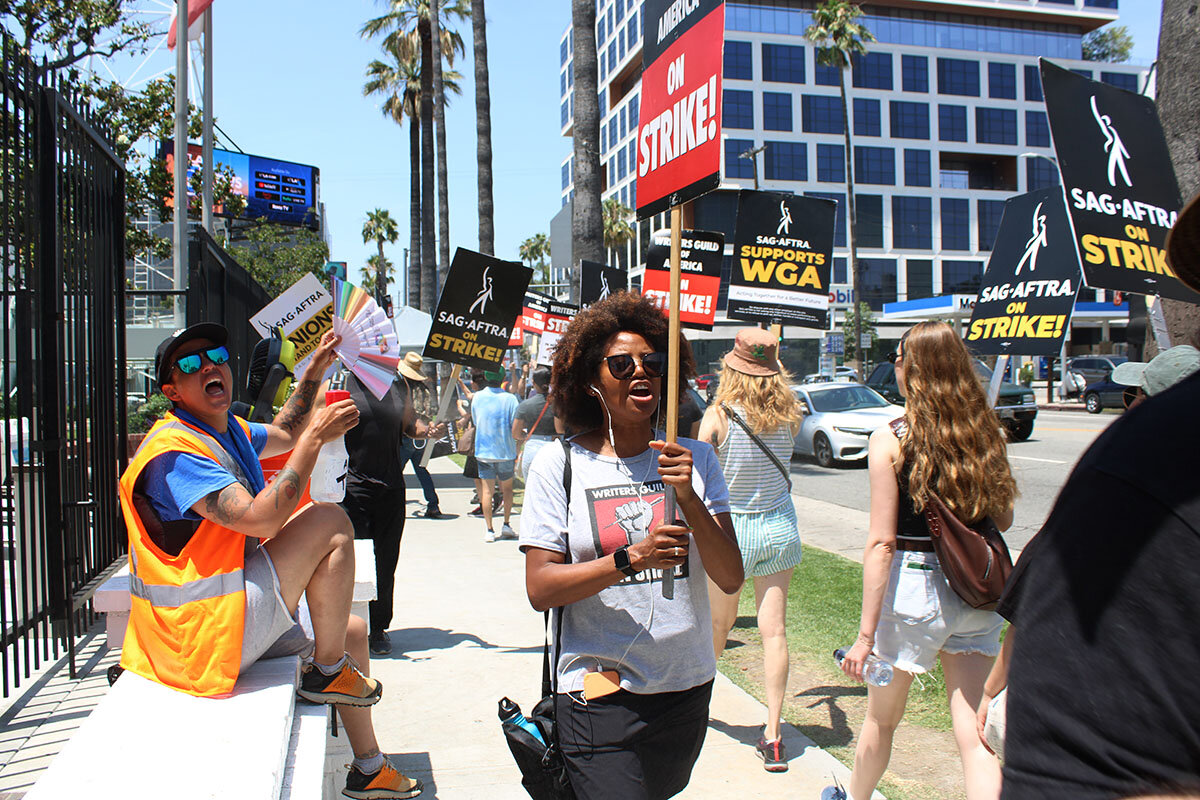AI, residuals, and lack of trust. Can Hollywood find a happy ending?
Loading...
| Los Angeles and Boston
Outside Netflix headquarters, the sidewalk is filled with actors and writers marching together in a historic strike. It’s over 90 degrees Fahrenheit. A few palm trees, towering over the street like giant dandelions, offer scant shade. Yet the protesters, holding fans and picket signs, are in good spirits as they chant slogans such as “LA is a union town, on strike, shut it down ...”
Actors put down their scripts and walked off sets last week. That is, off the movies and TV shows that hadn’t already paused production when the Writers Guild of America commenced its strike in May. The unions representing performers and writers have each reached an impasse with the Alliance of Motion Picture and Television Producers during their respective contract negotiations.
Tourists hoping to spot A-list actors, ready for their close-ups here on Sunset Boulevard, will be disappointed. Most of the 160,000 members of the Screen Actors Guild-American Federation of Television and Radio Artists (SAG-AFTRA) are journeyman actors working in video games, audiobooks, commercials, corporate or educational videos, and even puppetry.
Why We Wrote This
A story focused onWhat led to the first double strike of actors and writers in more than 60 years? Both sides point to a business model under severe strain even before the pandemic and a breakdown in trust.
“We’re not people that are living in mansions, living in luxury, drinking green smoothies all day,” says Gabriel Rissa, who works in a restaurant to supplement his roles in TV shows such as “Scandal” and “American Auto.” “It’s people that believe so strongly in their art that they’re willing to make sacrifices.”
At a time of upheaval in the entertainment industry, the question of who should make sacrifices is at the core of this double strike – the first time both unions have walked off the job together in 63 years. Actors, and before them writers, point to a vanishing middle-class life, brought on by the shift to streaming models that weren’t governed by previous agreements. That erosion of quality of life began before the pandemic, and prior to the recent rapid advances in artificial intelligence. For their part, studio executives at Walt Disney Co. and others point to cratering revenues and stock prices that meant they were laying off thousands of employees before the creative talent walked off the job. Both sides are gearing up for a long fight. And the sharp rhetoric reveals a breakdown of trust amid profound industry disruption.
“People are recognizing that this is a historic moment,” says Brian Welk, a senior business reporter for IndieWire, a film industry site. “It was shocking to me to see just how many actors and writers together were all very much on the same page in terms of their agenda and how unified they were.”
The fallout of the strikes is most acute in Los Angeles and New York, where whole economies of scale are powered by the engine of the entertainment industry. But the shutdown will also be felt across Hollywood’s many regional production hubs, including Georgia, New Mexico, and Louisiana. The impact is also global. Clapper boards fell silent in filming locations such as Morocco and Australia, where “Gladiator 2” and “Mortal Kombat 2,” respectively, had been filming.
Award shows such as the 75th Primetime Emmy Awards in September are at risk of being postponed. Union rules also prohibit actors from promoting movies. On Thursday, the cast of “Oppenheimer” made a show of departing the London premiere when confirmation of the work stoppage came through. During a red carpet interview, actor Matt Damon said that the reason for the strike was “to protect the people who are kind of on the margins,” especially those who rely on health insurance.
Carlease Burke is one of them. With about 170 credits, she’s enjoyed decades of steady acting in movies, commercials, and television shows such as “Dave” and “Mixed-ish.” During pandemic shutdowns, Ms. Burke was able to skate by for two years on her existing income. But three years ago, SAG-AFTRA changed the terms of its health care coverage. In order to qualify, actors must make a minimum of $26,000 from acting each year. That left the actress without insurance for the first time in her career.
As an older person, losing her health care and having to scramble to find an alternative was a blow. “We have really, really good health insurance, and so many people have lost it,” she says.
Some actors rely on residuals – payments received when a movie or television show is seen after its initial run, via reruns, or streaming or on-demand services – to get by or make enough money to qualify for the health insurance. One of the key sticking points in SAG-AFTRA’s negotiations with the Alliance of Motion Picture and Television Producers (AMPTP) is that streaming platforms are unwilling to reveal data that is key to determining those residuals.
“Companies have always tried to monopolize and monetize their own data to their own benefit and to [the detriment of] whoever they’re negotiating with,” says Mitch Lowe, author of the memoir “Watch and Learn: How I Turned Hollywood Upside Down with Netflix, Redbox, and MoviePass – Lessons in Disruption.” “No one is going to be happy until there is some third-party monitoring of the performance or complete transparency.”
Mr. Lowe, a co-founding executive at Netflix, says that archaic contract formulas should be updated to take into account not just subscription revenue but also other value generated by content, including licensing.
Streaming services have also changed the formula for determining residuals. Instead of paying actors a set amount according to how many times a program runs – as the networks do – streamers base their formula on the number of their subscribers. The AMPTP says actors have more opportunities to work because of streaming services, and that actors make money on streaming even if a show or movie flops. But performers say they aren’t getting their fair share when shows hit it big and that residual income has eroded. Since talks broke down, actors from Mandy Moore (“This Is Us”) to the cast of Netflix’s “Orange Is the New Black” have shared their residual checks from Netflix, with amounts ranging from pennies to $20.
In the meantime, metrics for measuring the success of streaming companies have also changed.
“Since early last year, Wall Street has started to get really concerned about the lack of profits in streaming,” says Ben Fritz, author of “The Big Picture: The Fight for the Future of Movies.” “Netflix had an earnings report when their growth was slowing, and Wall Street freaked out.’” Netflix, it should be noted, first reported a profit in 2003 and posted a $4.49 billion profit in 2022. Other direct-to-consumer streaming companies or divisions of larger corporations have yet to make money.
One of the easiest levers to pull to become more profitable is produce less content, says Mr. Fritz, whose Wall Street Journal podcast “With Great Power: The Rise of Superhero Cinema,” chronicles how Marvel came to dominate Hollywood. Indeed, Disney CEO Bob Iger recently announced that the company is cutting back on its multiverse’s worth of superhero offerings. In an increasingly common move, the company also pulled movies and TV shows from Disney+ as content write-offs – including ones released in 2023. And, like many other entertainment companies, it has also laid off thousands of employees.
Actors on the picket lines cite CEO compensation in the tens of millions of dollars as proof the studios have money to pay the people they hire. “How come they’re making so much money?” asks voice actor Hope Levy. “Look, we all want to work together. We’re all open to negotiating, but they need to be open to sharing their corporate wealth that they’re making.”
Economist Donald J. Boudreaux says that view is shortsighted, since employees prosper under adept CEOs, and the ability to run a global corporation is not a common skill.
“It’s worth pointing out the money [Mr. Iger’s] being paid does not belong to those employees. It belongs to the shareholders,” says Mr. Boudreaux, a former economics department chair at George Mason University. “If that person is not very good at doing what he or she does, then that affects the productivity of everyone down the line.”
This week, Moody’s Investors Service predicted that collective bargaining agreements with the unions will collectively cost studios an additional $450 million to $600 million per year.
An executive told Deadline that studios would hold out until the actors lost their homes and apartments – a tactic that didn’t go over well with actors and writers. Those on strike believe that studios don’t truly value them. For instance, a common fear of those on the picket lines outside Netflix is that studios will replace them with AI by scanning their image and likeness, and even their voices, and then utilizing them in perpetuity.
“Obviously we cannot stop technology, but we need to be compensated if they’re going to reuse our voice prints and our voices, or take our voice and then alter it,” says Ms. Levy, who has voiced animated characters in video games and TV movies.
In a statement to the Monitor, the AMPTP claims that SAG-AFTRA leadership has publicly mischaracterized its position on AI and reiterated its position that the deal offered “historic” pay and residual increases. “The current AMPTP proposal only permits a company to use the digital replica of a background actor in the motion picture for which the background actor is employed. Any other use requires the background actor’s consent and bargaining for the use, subject to a minimum payment.”
SAG-AFTRA did not respond to the Monitor’s request for comment.
For now, the unions and the studios are engaged in a public relations battle. Audiences may not notice the disruption in production until September, when bemused viewers notice the most hyped offering on fall TV is ... “The Golden Bachelor.” In the meantime, striking writers and actors keep turning up to march, no matter the temperature.
“Most creatives that I know have been without work for a year” and take on second or third jobs to get by, says Dominique Generaux, whose first movie role was the 2008 film “Dakota Skye.” “So for us, when it’s such an existential crisis, people will go as long as it takes.”









